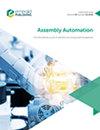The welding tracking technology of an underwater welding robot based on sliding mode active disturbance rejection control
IF 1.7
4区 计算机科学
Q3 AUTOMATION & CONTROL SYSTEMS
引用次数: 1
Abstract
Purpose A welding robot is a complicated system with uncertainty, time-varying, strong coupling and non-linear system. It is more complicated if it is used in an underwater environment. It is difficult to establish an accurate dynamic model for an underwater welding robot. Aiming at the tracking control of an underwater welding robot, it is difficult to achieve the control performance requirements by the classical proportional integral derivative control method to realize automatic tracking of the seam. The purpose of this paper is to suggest a novel method to deal with these issues. Design/methodology/approach To combine the advantages of active disturbance rejection control (ADRC) and sliding mode control (SMC) to improve the shortcomings of a single control method, a hybrid control method for an underwater welding robot trajectory tracking based on SMC_ADRC is proposed in this research work. Findings The simulation experiment of the proposed approach is carried out by Matlab/Simulink, and the welding experiment is recorded. The seam gets plumper and smoother, with better continuity and no undercut phenomenon. Originality/value The proposed approach is effective and reliable, and the system’s tracking performance is stable, which can effectively reduce chattering and improve system robustness.基于滑模自抗扰控制的水下焊接机器人焊接跟踪技术
焊接机器人是一个具有不确定性、时变性、强耦合性和非线性的复杂系统。如果在水下环境中使用,它会更加复杂。水下焊接机器人难以建立精确的动力学模型。针对水下焊接机器人的跟踪控制,采用经典的比例-积分-微分控制方法实现焊缝的自动跟踪很难达到控制性能要求。本文的目的是提出一种处理这些问题的新方法。设计/方法/方法为了结合自抗扰控制(ADRC)和滑模控制(SMC)的优点来改善单一控制方法的缺点,本文提出了一种基于SMC_ADRC的水下焊接机器人轨迹跟踪混合控制方法。结果利用Matlab/Simulink对该方法进行了仿真实验,并记录了焊接实验。接缝更加饱满光滑,具有更好的连续性,没有咬边现象。独创性/价值该方法有效可靠,系统跟踪性能稳定,可以有效地减少抖振,提高系统鲁棒性。
本文章由计算机程序翻译,如有差异,请以英文原文为准。
求助全文
约1分钟内获得全文
求助全文
来源期刊

Assembly Automation
工程技术-工程:制造
CiteScore
4.30
自引率
14.30%
发文量
51
审稿时长
3.3 months
期刊介绍:
Assembly Automation publishes peer reviewed research articles, technology reviews and specially commissioned case studies. Each issue includes high quality content covering all aspects of assembly technology and automation, and reflecting the most interesting and strategically important research and development activities from around the world. Because of this, readers can stay at the very forefront of industry developments.
All research articles undergo rigorous double-blind peer review, and the journal’s policy of not publishing work that has only been tested in simulation means that only the very best and most practical research articles are included. This ensures that the material that is published has real relevance and value for commercial manufacturing and research organizations.
 求助内容:
求助内容: 应助结果提醒方式:
应助结果提醒方式:


